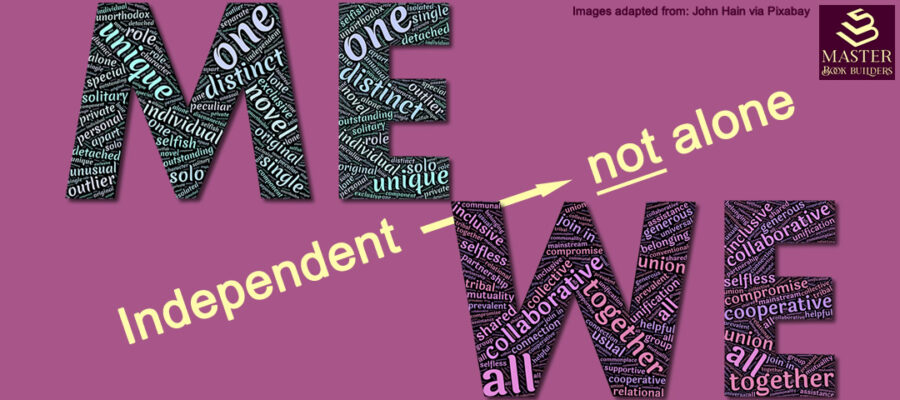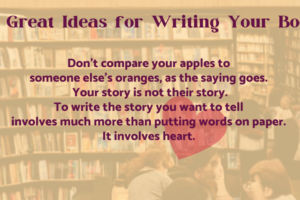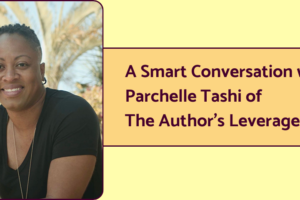The Indie Advantage
In a recent post I compared the author’s investment in the three main publishing models, labeling them Indie, Hybrid, and Traditional. Here I want to dig a bit deeper into the indie model and talk a bit more about the mindset behind it and parallels to the way indie musicians and indie filmmakers operate.
Stop calling it self-publishing. Just stop.
Why? Well, we’re all writers, right? We understand that words matter. Different words for things that are almost the same carry different nuances and call up very different images.
To us, the term self-publishing hauls along the baggage of “vanity” publishing and amateurish production values. Worse, it implies that the author works solo, creating the book, marketing the book, distributing the book in a lonely and often frustrating battle.
An indie author, as we use the term, maintains control of the writing, publishing, and marketing, but as a professional, treating the process as a serious business.
The Alliance of Independent Authors allows the terms self-published and indie author to overlap:
Self-publishing author: any author who has published a book at personal expense. Self-publishers range the full gamut, from those publishing a one-off book for family and friends to the most entrepreneurial and productive authorpreneur.
Indie Author (also called author-publishers): Any author who self-publishes to sell, who takes publishing seriously, wants to reach as many readers as possible, and grow a profitable author-publishing business.
We think this obscures the important mindset shift that an indie author brings to the endeavor, which the AIA describes well earlier on the same page of its website:
Unlike authors who self-publish a book for family, friends or community, an indie author (wants to) make a living from writing and publishing books. They are “indie” because compared to authors who sign exclusive deals with a single trade publisher, or a single self-publishing service, they are relatively independent – the creative director of their own books, and their own publishing business.
A good book and a good publishing business is always a team effort and indie authors employ a variety of services to accomplish the seven processes of publishing (editorial, design, production, distribution, marketing, promotion and rights licensing) to professional standards.
That’s the distinction in a nutshell.
And take special note of that line “creative director of their own books, and their own publishing business.”
One of the crucial steps we urge our clients to take is to form their own publishing company, which will purchase its own block of ISBNs and publish the client’s books with its own distinctive imprint.
We’ll see in a moment one spectacular example, but first let’s compare how “indies” operate in the music and film industries.
What would Taylor, Chance, Reece, and Idris do?
Book publishing isn’t the only industry where technology has enabled individual creatives to go around the established corporate giants directly to their audiences.
Yvonne recently wrote about the Taylor Swift Model of Book Marketing and that’s the aspect that is most “indie” about her career. She has built a direct connection with her fans and personally attends to their wishes and concerns. Yet she formed her own management company, 13 Management, early on. You can see a sample of the teams she relies on by visiting any of her music videos, e.g., Lavender Haze, where the credits list her name, but only in the first and last lines:
Director: Taylor Swift
Director of Photography: Rina Yang
Producer: Sara D’Alessio
Editor: Chancler Haynes
Production Designer: Ethan Tobman
1st AD: Anthony Dimino
Visual Effects: Parliament
Production Companies: Taylor Swift Productions & Revolution Pictures
For Swift, maintaining creative control and ownership of her songs has been her core purpose.
A more fully “indie” example is Chance the Rapper. One Submit describes him as “the poster boy for successful independent artists worldwide.” Showing how the growth of technology empowers artists to reach audiences directly, Chance began his career releasing his music via online streaming platforms.
He is the first music artist to win a Grammy award without selling any physical copies of his music nor selling much of his music at all.
With his Chance the Rapper, LLC, production company, he’s now helping other artists pursue their dreams. The same One Submit blog post describes the paths to indie success taken by Macklemore, Boyce Avenue, Mýa, and Frank Ocean. Some of them started with established record labels, others remained indie from the start.
Of those who signed with labels, Boyce Avenue pulled out after a year, because they found the label “moved too slowly to cater to their fan base.” Echoing what we’ve heard from authors who’ve tried the traditional and hybrid publisher routes, they were “disappointed with the reality of what the major label provided.” And Frank Ocean explained his departure from Def Jam Records with the quip, “It was like a bad marriage.”
Famous examples from the film industry include Reese Witherspoon, who started Type A Films in 2000. The evolution of that startup into Hello Sunshine shows the complexity of what it means to be an “indie filmmaker.” Nobody can make a movie alone, unless its a two-hour selfie shot on your cell phone.
This point about indie artists needing a team is driven home by the inspirational example of Idris Elba’s Green Door Pictures, which explains on its about page:
Green Door Pictures exists to enable a more direct route to goal for talented film and TV series writers, actors, directors and producers to bring the best of diverse storytelling to a global audience.
Forget the two-hour selfie and understand that you’re unlikely to succeed without building a team.
What about indie authors?
I promised you a spectacular example and here he is: Brandon Sanderson. Like some of the musician examples, Sanderson has published many books in the traditional model. His story reminds us of the pain and time usually involved in going that route.
He began writing “in earnest” in 1997, while working nights and going to school in the daytime. Six years later, after “quite a pile of rejection letters” he got a call from an editor at Tor Books about publishing one of his books. This came a year and a half after he’d submitted that manuscript, when he’d “almost given up on hearing anything.”
While on that traditional path, Sanderson also became a great example of taking primary responsibility for marketing himself and his books directly to his audience, to the point of running his own book club from his website and YouTube (with 463,000 subscribers as of this writing).
Now for the “overnight success” indie publishing part: In 2022 (25 years after he started writing in earnest), Sanderson decided to try indie publishing and formed Dragonsteel Books as his own publishing company, with a simple website connected to his main site.
One interesting tidbit about needing a team, although it’s not clear how many team members Sanderson may employ or contract with, when I was on the site today it had a footer link “Jobs at Dragonsteel” with a listing for a “warehouse clerk.”
Sanderson also decided to give himself an “advance” for a four book project. He set up a Kickstarter campaign to fund what he called “Four Secret Novels,” offering very little description of what the books would be about, supposedly to avoid spoilers. (He later released video trailers and readings, with the titles, on the YouTube book club channel.)
He set an initial goal of $1,000,000. Hey, he was already a successful author, right?
To date, the campaign has raised $41,754,153.
The point here, of course, is not how rich Brandon Sanderson got with his unique, record-breaking campaign. It’s what you can learn from how he runs his writing and publishing career, including:
- Success, however you define it, takes time, commitment, and doing the work.
- For creatives, effective marketing means personal involvement in connecting with your audience.
- And staying free to do your work and make those connections requires building a team.
Just like the indie musician and filmmaker examples above.
An older, but still favorite example of mine, Virginia Woolf started her own publishing company, Hogarth Press, along with her husband,
to escape the creative restraints of conventional publishing houses, and to produce books that more commercial publishers might eschew.
Another husband-wife team!
The Indie Author Mindset
For years, Yvonne and I have told audiences at conferences, readers of our writings, clients, friends, acquaintences — you get the idea — that writing and publishing a book means you are starting a small business. That is, assuming you want to sell the book and have it read by more than your immediate family and a few dedicated friends.
Whatever title you choose for your role — owner, CEO, creative director — your new business will have the best chance of producing a product you can be proud of and becoming a success if you gather a team of specialists and experts to handle the tasks you haven’t mastered.
That approach allows you to focus on the parts only you can do best: writing your book(s) and building a personal connection with your audience.
I’m happy to see the Indie Author label being used more and more, by the likes of Publishers Weekly and the AIA (quoted above), though they still use self-publishing as an overlapping term.
It’s time to separate the two and get your “indie author” mindset on!






14 Comments
Leave your reply.